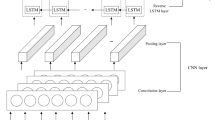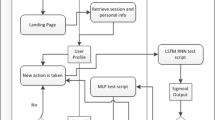Abstract
Recently, click-through rate (CTR) prediction is a challenge problem in the aspect of online advertising. Some researchers have proposed deep learning-based models that follow a similar embedding and MLP paradigm. However, the corresponding approaches generally ignore the importance of capturing the latent user interest behind user behaviour data. In this paper, we present a novel attentive deep interest-based network model called ADIN. Specifically, we capture the interest sequence in the interest extractor layer, and the auxiliary losses are employed to produce the interest state with the deep supervision. First, we model the dependency between behaviours by using a bidirectional gated recurrent unit (Bi-GRU). Next, we extract the interest evolving process that is related to the target and propose an interest evolving layer. At the same time, attention mechanism is embedded into the sequential structure. Then, the model learns highly non-linear interactions of features based on stack autoencoders. An experiment has been done using four real-world datasets, the proposed model achieves superior performance than the existing state-of-the-art models.







Similar content being viewed by others
References
Chapelle O, Rosales R, Rosales R (2015) Simple and scalable response prediction for display advertising [M]. ACM
Jahrer M, Toscher A, Lee J Y, et al. (2012) Ensemble of collaborative filtering and feature engineered models for click through rate prediction[C]//KDDCup workshop
Cheng H T, Koc L, Harmsen J, et al. (2016) Wide & Deep Learning for recommender systems[C]// the workshop on deep learning for recommender systems. ACM, 7–10
Najafi-Asadolahi S, Fridgeirsdottir K (2014) Cost-per-click pricing for display advertising[J]. Manuf Serv Oper Manag 16(4):482–497
Richardson M, Dominowska E, Ragno R (2007) "Predicting clicks: estimating the click-through rate for new ads." Proceedings of the 16th international conference on World Wide Web. ACM
Chapelle O, Manavoglu E, Rosales R (2015) Simple and scalable response prediction for display advertising[J]. ACM Trans Intell Syst Technol (TIST) 5(4):61
Chapelle O (2014) "Modeling delayed feedback in display advertising." Proceedings of the 20th ACM SIGKDD international conference on Knowledge discovery and data mining. ACM
McMahan, HB, et al. (2013) "Ad click prediction: a view from the trenches." Proceedings of the 19th ACM SIGKDD international conference on Knowledge discovery and data mining. ACM
Chang YW, Hsieh CJ, Chang KW et al (2010) Training and testing low-degree polynomial data mappings via linear SVM[J]. J Mach Learn Res 11(Apr):1471–1490
Wang B (2013) Advertisement click-through rate prediction using multiple criteria linear programming regression model [J]. Proc Comput Sci 17:803–811
Rendle S (2012) "Factorization machines with libfm." ACM Trans Intell Syst Technol (TIST) 3.3: 57
Rendle S, Schmidt-Thieme L (2010) Pairwise interaction tensor factorization for personalized tag recommendation[C]//proceedings of the third ACM international conference on web search and data mining. ACM:81–90
Juan Y, et al. (2016) "Field-aware factorization machines for CTR prediction." Proceedings of the 10th ACM Conference on Recommender Systems. ACM
He X, et al. (2014) "Practical lessons from predicting clicks on ads at facebook." Proceedings of the Eighth International Workshop on Data Mining for Online Advertising. ACM
LeCun Y, Bengio Y, Hinton G (2015) "Deep learning." Nature 521.7553: 436
Chen LC, Papandreou G, Kokkinos I et al (2018) Deeplab: semantic image segmentation with deep convolutional nets, atrous convolution, and fully connected crfs[J]. IEEE Trans Pattern Anal Mach Intell 40(4):834–848
Amodei D, Ananthanarayanan S, Anubhai R, et al. (2016) Deep speech 2: End-to-end speech recognition in english and mandarin[C]//International conference on machine learning: 173–182
Young T, Hazarika D, Poria S et al (2018) Recent trends in deep learning based natural language processing[J]. IEEE Comput Intell Mag 13(3):55–75
Gao H, Kong D, Lu M et al (2018) Attention convolutional neural network for advertiser-level click-through rate forecasting[C]//proceedings of the 2018 world wide web conference on world wide web. International World Wide Web Conferences Steering Committee:1855–1864
Zhang W, Du T, Wang J (2016) Deep learning over multi-field categorical data[C]//European conference on information retrieval. Springer, Cham, pp 45–57
Liu Q, Yu F, Wu S et al (2015) A convolutional click prediction model[C]//proceedings of the 24th ACM international on conference on information and knowledge management. ACM:1743–1746
Zhang Y, Dai H, Xu C, et al. (2014) Sequential Click Prediction for Sponsored Search with Recurrent Neural Networks[C]//AAAI. 14: 1369–1375
Qu Y, Cai H, Ren K et al (2016) Product-based neural networks for user response prediction[C]//2016 IEEE 16th international conference on data mining (ICDM). IEEE:1149–1154
Shan Y, Hoens TR, Jiao J et al (2016) Deep crossing: web-scale modeling without manually crafted combinatorial features[C]//proceedings of the 22nd ACM SIGKDD international conference on knowledge discovery and data mining. ACM:255–262
Zagoruyko S, Komodakis N (2016) Wide residual networks[J]. arXiv preprint arXiv:1605.07146
Wang R, Fu B, Fu G et al (2017) Deep & cross network for ad click predictions[C]//proceedings of the ADKDD'17. ACM 12
Guo H, Tang R, Ye Y, et al. (2018) DeepFM: An End-to-End Wide & Deep Learning Framework for CTR Prediction[J]. arXiv preprint arXiv:1804.04950
Xiao J, Ye H, He X, et al. (2017) Attentional factorization machines: Learning the weight of feature interactions via attention networks[J]. arXiv preprint arXiv:1708.04617
Vaswani A, Shazeer N, Parmar N, et al. (2017) Attention is all you need[C]//Advances in neural information processing systems: 5998–6008
Wang Q, Liu F, Xing S et al (2018) A new approach for advertising CTR prediction based on deep neural network via attention mechanism[J]. Comput Math Method Med 2018
Ghasemi F, Mehridehnavi A, Fassihi A et al (2018) Deep neural network in QSAR studies using deep belief network[J]. Appl Soft Comput 62:251–258
Zhou G, Zhu X, Song C et al (2018) Deep interest network for click-through rate prediction[C]//proceedings of the 24th ACM SIGKDD international conference on Knowledge Discovery & Data Mining. ACM:1059–1068
Chung J, Gulcehre C, Cho KH, et al. (2014) Empirical evaluation of gated recurrent neural networks on sequence modeling[J]. arXiv preprint arXiv:1412.3555
Hochreiter S, Schmidhuber J (1997) Long short-term memory[J]. Neural Comput 9(8):1735–1780
Hidasi B, Karatzoglou A, Baltrunas L, et al. (2015) Session-based recommendations with recurrent neural networks[J]. arXiv preprint arXiv:1511.06939
Vincent P, Larochelle H, Bengio Y, et al. Extracting and composing robust features with denoising autoencoders[C]//Proceedings of the 25th international conference
Baltrunas L, et al. (2015) "Frappe: Understanding the usage and perception of mobile app recommendations in-the-wild." arXiv preprint arXiv:1505.03014
Harper FM, Konstan JA (2016) "The movielens datasets: History and context." ACM Transactions on Interactive Intelligent Systems (TiiS) 5.4: 19
Li L, Greene T, Hu B (2018) A simple method to estimate the time-dependent receiver operating characteristic curve and the area under the curve with right censored data[J]. Stat Methods Med Res 27(8):2264–2278
Zhang L, Shen W, Huang J et al (2019) Field-aware neural factorization machine for click-through rate prediction[J]. IEEE Access 7:75032–75040
Holzinger A (2018) "From machine learning to explainable AI." 2018 World Symposium on Digital Intelligence for Systems and Machines (DISA). IEEE
Acknowledgments
This work was supported by the following grants: National Natural Science Foundation of China (61572300,81871508,61773246); Taishan Scholar Program of Shandong Province of China (TSHW201502038); Natural Science Foundation of Shandong Province (ZR2018ZB0419); Primary Research and Development Plan of Shandong Province (2017GGX10112).
Author information
Authors and Affiliations
Corresponding author
Additional information
Publisher’s note
Springer Nature remains neutral with regard to jurisdictional claims in published maps and institutional affiliations.
Rights and permissions
About this article
Cite this article
Li, H., Duan, H., Zheng, Y. et al. A CTR prediction model based on user interest via attention mechanism. Appl Intell 50, 1192–1203 (2020). https://doi.org/10.1007/s10489-019-01571-9
Published:
Issue Date:
DOI: https://doi.org/10.1007/s10489-019-01571-9




